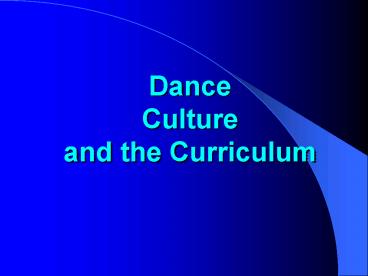Dance Culture and the Curriculum - PowerPoint PPT Presentation
1 / 28
Title:
Dance Culture and the Curriculum
Description:
Of beauty and ugliness, love and hate, anger and hope, trust and mistrust. and ... Political change from minority-led, racially and culturally ... Experts ... – PowerPoint PPT presentation
Number of Views:24
Avg rating:3.0/5.0
Title: Dance Culture and the Curriculum
1
Dance Culture and the Curriculum
2
South Africa a country of great contradictions
- Of beauty and ugliness, love and hate,
- anger and hope, trust and mistrust
- and
- A country in a period of exciting,
- challenging and frightening transformation
3
Background
- Political change from minority-led, racially and
culturally segregated rule to a majority-led,
multicultural democracy - Past apartheid policies excluded, disempowered
and marginalised many, resulting in high levels
of illiteracy, unemployment, poverty and social
dysfunction.
4
A new democratic government has brought the
opportunity for designing a radically new
curriculum which includes
- Arts and Culture Grade 0 9
- and
- Dance Studies Grade 10 12
5
Curriculum Planning
- Context, considerations, concerns and constraints
- Accommodation of local needs (and especially
cultural diversity) as well as global needs - Tensions of conflicting economic, political,
social, cultural and educational imperatives
6
Context
- Transformational Outcomes-Based
- Representation from all races, genders and
stakeholders - Change in the hidden curriculum from colonially
imposed Christian National Education to African
Renaissance emphasisingUbuntu - humanism
human rights, social justice, equality and
democracy
7
Considerations
- Redress the past
- Promote a culture of human rights and justice
- Ensure access, inclusion, equality,
multi-culturalism, gender equity - Be sensitive to issues of indigenous knowledge
8
Concerns
- Representative writing groups unequal in capacity
- Broad participation process slow
- Contested terrain, protect turf
- Tension between local very different contexts vs
national standards - Tension between integrated African approach and
Western discipline-specific approach
9
Tension no. 1
- African Arts
- Integrated
- Communal
- Part of daily life
- Inclusive
- Western Arts
- Discipline SpecificCelebrate Individual
artistExperts
10
After decades of colonialism, anything hinting of
European imperialism, such as classical music or
ballet, was considered suspect. Excellence
considered a politically incorrect word of
exclusion
11
At the same time, the spirit of cultural
inclusion required that classical music and
ballet not be excluded and that access to these
art forms be made available to those who were
denied such access in the past.
12
The challenge - to accommodate all cultures
- Permeate cultural borders
- Challenge cultural assumptions in unique ways.
- Acknowledge evolving of cultures
13
African dance purists
- Tampering with culture and heritage
- Artificial appropriation superficial
application vandalising the essence of the form - Preserve dances in their original form -
remaining true to their origin, function and
meaning and as generational transmission of
histories and ways of life
14
Traditional Dance
- Ask for permission to use rituals and traditions
on stage
15
Tension 2
- A number of imperatives seemed to be in conflict
with each other - Social reconstruction emphasising cultural,
social, personal goals - Economic reconstruction emphasising global
competitiveness, high skills and knowledge, job
creation
16
Hotly debated question
- What should schools teach?
- Should it be
- about arts and culture?
- through the arts?
- or in the arts?
17
Which imperative could we serve?
- Cultural
- Previously the basis for stereotyping,
discrimination, prejudice - Should transmit and preserve culture
- Promote cultural awareness
- Celebrate cultural diversity
- Political
- Advance ideology of the ruling party
- Promote nation building
18
Economic
- Induct into discipline-specific knowledge towards
tertiary training a career? - Develop dance literacy to build informed
audiences? - Personal
- Nurture and develop creativity, resourcefulness,
confidence and self-esteem promote healing - Social
- Develop social interactive skills the ability
to communicate, share, care, lead, follow,
negotiate (very important in a new democracy)
19
Instrumentalist Approach
- Arts as a vehicle to teach across the curriculum
- Holistic learning, vibrant tool
- BUT
- No progress beyond the scribble/dabble stage
- Deny accumulation of economic or cultural
capital, or entry into the discipline-specific
knowledge hierarchy and thereby reproduce
marginalisation. - Violates the right to excellence
- Explorations within limited pedestrian vocabulary
soon boring - Undermining dance as an respected and autonomous
subject worthy of a place in the curriculum
20
Constraints
- i) what the country can afford (class sizes 40-
60) - ii) who could teach the learning area and
- Iii) how much leeway the timetable would allow.
21
Partial Solutions
- Reconciliation - cater for all
- Eclectic Arts and Culture curriculum includes the
arts separately and together, reaching across
cultures - Our curriculum is overloaded
22
New Possibilities
- The Dance Studies Grade 10 12 Curriculum is
structured under the umbrella of choreography and
includes a major dance focus and an outcome on
indigenous dance.
23
Focus on creativity
- African dance has become part of the formal and
non-formal curriculum, influenced by, and
influencing, other dance forms
24
Unique emergent SA culture
- Countrys transition is impacting on everything -
interesting times new world opening up - Innovative artists experimenting with fusion
25
Empower the teachers
- Massive teacher re-training
- Generate new teacher qualifications
26
Cross Cultural Dance
- Avoiding ethnic-tribal stereotyping
27
Conclusion
- Richness of debate emerges from difference
- Culture strongly emphasised throughout the
curriculum - Not business as usual
- New horizons of expectations new possibilities
- Iterative process of trial, reflection and
adaptation - Curriculum needs to be dynamic and responsive
28
Dance is exploding No limits, no boundaries































